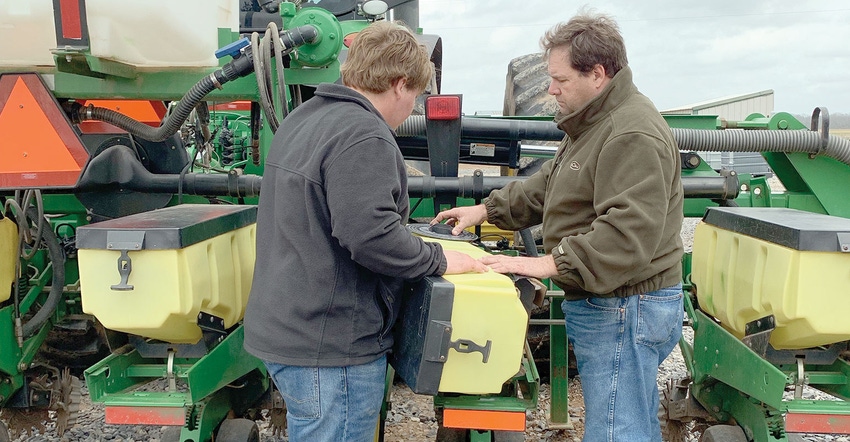
J.K. Bordelon, on a foggy February morning with humidity so high the concrete floor of the farm shop was sweating too much for comfort, sat in a rocking chair in the kitchen of his Moreauville, La., home and talked about farming.
Bordelon, that’s French, he says, with family dating back to the early to mid-1700s. He’s the fourth generation to farm this place and he talks about challenges he faces with the coming year — markets, crop mix, drainage, the increasingly high cost of producing crops and the need for infrastructure renovation.
He plants corn, soybeans and grain sorghum, occasionally cotton if profit potential looks better than the risk.
“We can make cotton here,” he says. “Bringing it to harvest is the problem.”
Often, wet harvest seasons promote boll rot and fiber quality deterioration. “We can make two-bale plus cotton, we just can’t pick it.”
Cotton would be a good rotation with beans and corn. “We’re just a bit too far south to grow cotton,” he says. He farms in Avoyelles Parish in east central Louisiana.
Soybeans and corn
This year, he plans on 60 percent soybeans and 40 percent corn — grain sorghum an option if needed for rotation.
“Some of my clay land is not good for corn,” Bordelon says. “It dries out and cracks. That’s where I need grain sorghum. It’s my go-to for rotation; otherwise I have three years of soybeans.”
The problem with sorghum, however, is lack of a market.
Corn and soybean crops did well last year. “We haven’t missed a corn crop in several years,” he says.
Although fall rains spread out soybean harvest, he had no damage. A lot of bean fields had intermittent planting dates, Bordelon says. Planting season was interrupted by a long dry spell; some fields had early- and late-planted beans. Harvesting was difficult.
“I waited until conditions were right and planted later.” That planting date, well into June, was later than crop insurance deadlines, but Bordelon buys only minimal crop insurance. “I farm to make a crop and I do what’s best to make it.”
He says some crop insurance restrictions limit best management practices.
“My crop was uniform and, even with an extended harvest, I had no pod damage.”
Grain grading
One of his pet peeves, he says, is inconsistent grain grading at elevators. He’s noted that grain trucked to a processor in Mississippi grades higher than at elevators closer home. Training, he says, could be an issue, but convenience for the elevator could also be a factor.
The grain handling infrastructure is aging. “The facilities are getting old. A few renovations have been done but the newest elevator in this area was built in 1984. Others are older than that.”
He says markets may be a factor in the unwillingness to upgrade grain facilities. “The emphasis is on emerging markets in Central and South America, our competitors,” he says. “(Grain buyers) are trying to get the overseas market and assume they have the domestic one. We have sold some corn to Pilgrim’s Pride up in Natchitoches.”
Drainage also needs updating, Bordelon says. “That’s a never-ending saga. Drainage systems are 40, 50, 60 years old and have not been improved.” Cost and some landowners’ objections to cleaning out ditches contribute to the problem.
Bordelon anticipates more land going into conservation programs in the next few years. Changing markets, he says, will encourage taking marginal land out of production and putting it in the Wetlands Reserve Program (WRP) and the Conservation Reserve Program (CRP). “Marginal land that was not enrolled in the last 10 years could go into trees and wildlife habitat — ducks and deer,” he says.
The drainage problems also may encourage more land into WRP.
Finding a profitable mix in current markets offers another challenge. He’s not anxious to price any of his 2019 bean or grain crops yet. “For the first time since 1995, I have nothing sold at this time of the year. That may be a good thing. I have seen nothing above or far below where it was 18 months ago.”
High production costs
But production costs remain high. Bordelon says the high cost of “repair and replacement parts irks me. Equipment manufacturers put astronomically high prices on parts. We have a few after-market companies, but some parts are specific to the manufacturer.”
He says in some cases a specific part is not available without buying the entire component.
Consolidation results in limited competition, he adds. Same goes for seed and chemicals.
He says considering the cost of soybean seed and the millions of acres planted in the United States, “that’s a lot of money” back to seed companies.
Bordelon plans no big changes for 2019. He has some furrow irrigation, plants on 38-inch rows and stays with conventional tillage. “I tried no-till but unless you have cover and you get freezing temperatures, it doesn’t work well. And you’re always one wet harvest away from going back to tillage.”
What he needs for now is warm, dry weather. The rainy trend that started last fall has persisted into the winter. Farmers need to get into the fields.
Despite the market, production costs, and infrastructure challenges, by mid-February, Bordelon was anxious to get busy and get start making another crop.
About the Author(s)
You May Also Like






